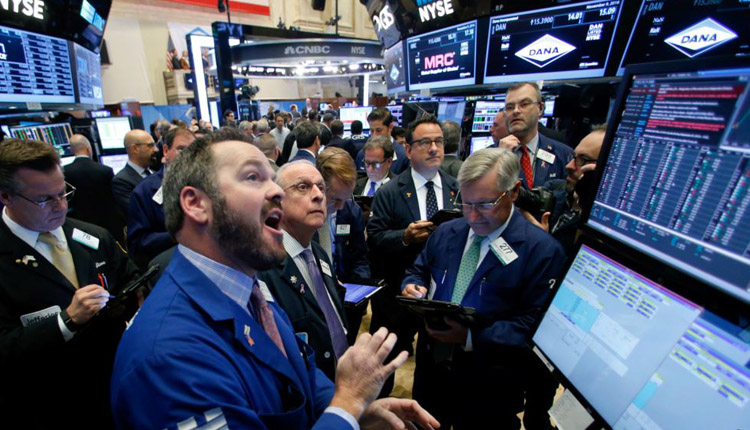The Dow Jones Industrial Average and S&P 500 closed lower on Wednesday after the Federal Reserve’s latest monetary-policy announcement dragged Treasury yields lower, pushing bank shares down.
Goldman Sachs led the 30-stock Dow to end the day down 141.71 points at 25,745.67. The S&P 500 closed 0.3 percent lower at 2,824.23. The Nasdaq Composite eked out a gain, closing 0.1 percent higher at 7,728.97.
The Fed forecast no rate hikes in 2019, and that is down from two hikes forecast earlier. The central bank also indicated it intends to end the reduction of its massive $4.2 trillion balance sheet by September. However, the Fed also trimmed its economic growth forecast for 2019.
Stocks initially rallied off their lows of the day on the announcement as traders cheered a more accommodative policy stance from the Fed, which is typically supportive of equity prices.
“Expectations were to remove one dot from the dot plot and to have some description of when the balance sheet run-off would conclude,” said Art Hogan, chief market strategist at National Securities. “This actually exceeds expectations.”
However, the Fed’s announcement also dragged down yields, which in turn knocked bank stocks lower. The benchmark 10-year rate falling to its lowest level in a year to trade at 2.532 percent. The 2-year yield also dropped to 2.4 percent.
Bank stocks fell broadly along with rates. The SPDR S&P Bank ETF (KBE) dropped 3.2 percent. Goldman Sachs declined 3.4 percent while Bank of America, Morgan Stanley, J.P. Morgan Chase and Citigroup all fell at least 2 percent.
“The market might be pricing in more than a cut through next year,” said Mike Collins, senior portfolio manager at PGIM Fixed Income. “It feels like their done.”
However, “it’s really a tricky spot. If things slow too much and the Fed starts cutting, that’s actually not a great environment for equities or corporate earnings or credit risk,” Collins said. “It can become a self-fulfilling prophecy, for sure.”
Equities were also under pressure after President Donald Trump said U.S. tariffs on Chinese goods could stay on for a long period of time.
“We’re not talking about removing [tariffs], we’re talking about leaving them for a substantial period of time because we have to make sure that if we do the deal with China that China lives by the deal,” Trump told reporters. His comments confused some traders, however, as Trump also said a deal is “coming along nicely.”
His comments come a day after Bloomberg News reported some U.S. officials are worried China could walk back on some concessions. However, The Wall Street Journal said U.S. Trade Representative Robert Lighthizer and Treasury Secretary Steven Mnuchin both plan to travel to Beijing next week for another round of negotiations with Chinese Vice Premier Liu He. These reports buffeted stocks on Tuesday.
China and the U.S. have been working on a deal for weeks and investors have priced in one being done. Concerns over global growth also weighed on stocks prior to the Fed’s announcement.
FedEx shares fell more than 3 percent after CFO Alan Graf warned in the company’s quarterly report that “slowing international macroeconomic conditions and weaker global trade growth trends continue, as seen in the year-over-year decline in our FedEx Express international revenue.”
That warning was followed by UBS CEO Sergio Ermotti saying this is one of the worst first-quarter environments ever as investment banking revenue falls about a third from the year-earlier period. Meanwhile, German auto maker BMW said its earnings could fall significantly in 2019 and added it will cut $13.6 billion in costs.
“We’re not out of the woods by any means,” said Christian Fromhertz, CEO of The Tribeca Trade Group. “These are things that continue to be bumps in the road with the equity market.”
“The Fed needs to stay dovish and you need a trade deal to eventually get done. You’re seeing that through FedEx and BMW.”
Source: CNBC
